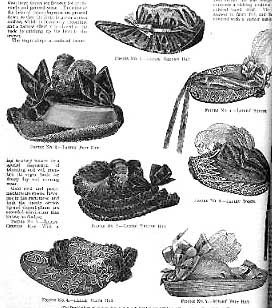La Belle Époque 1890-1914
Women's dress in the 1890's continued to be built in a sturdy, heavy, upholstered style, but the silhouette changed to that of an hour glass. Female bodies were corseted to a small waist, and then padded in the buttocks, hips, bosom and sleeves to exaggerate the apparent wasp-waisted effect.
Hats began to grow larger in the 1890's, a trend that continued steadily until 1911.
Men's Dress in the 1890's took a turn towards greater formality and dandyism in Europe, and went in the opposite direction in the U.S. where the popular mode was brightly colored sportswear.
American men of around 1900 tried to emulate the image of the "Arrow Shirt Man" drawn by J.C.Leyendecker, with brightly colored shirts and hard white tubular collars worn under the sporty Sack Suit jackets, that had recently moved up from sport clothes to business wear. During this period in the US, the European fashion for Frock coats like the Prince Albert Coat and the Cutaway is gradually displaced by the sack, so much so that even rich American men sport an evening version of the sack, the Tuxedo, to male only parties and semi formal events.
Most women's dress in this era was highly influenced by the advancing feminist cause, which after 1903 escalated to widespread civil disobedience by "Suffragettes" (radical suffragists). Women modeled their behavior and appearance upon the Gibson Girl the popular image of the "New Woman". Men's clothing styles such as the suit, shirt, hard collar and tie were worn by women forcing themselves into professions formerly occupied by men. Health fads of the 1890's and 1900's also encouraged women's sporting activities, particularly bicycling, which, in turn promoted sport clothing as a fashion.
Dress reform, continued to be a hot topic in this period, even gaining such notable adherents as Mark Twain.
Artists such as Mariano Fortuny in Italy and the Wiener Werkstaette group in Austria continued to design Aesthetic reform costumes such as Fortuny's Delphos Dress, and dress became progressively more comfortable, practical and aesthetically pleasing in this whole era. The beauty of the designs worn in this era are so apparent that the period 1890-1914 is commonly called la Belle Époque ("The Beautiful Epoch")
Mario Fortuny
Women's clothing after 1900 became lighter and lighter in construction and materials. A popular style in this period was the "Lingerie Dress" a feather-light white cotton dress inset with strips of open work lace and net.
After 1908, women's dress became more vertical in line, and less "S" curved. The vertical line became so pronounced after 1910 that highly fashionable dresses tended to hobble the wearer. Corsets began to be replaced by brasseries and other light foundation garments
Sunday, March 18, 2007
Subscribe to:
Comments (Atom)







